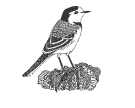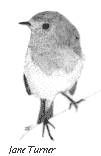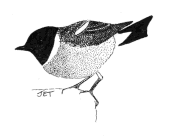|
The Hoylake “Bird Observatory” Bird Report for 2000-1 |
|||
|
Back to Newsletter
Systematic list - The status line included for each species is adapted from the Cheshire and Wirral Ornithological Society's bird report. Yellow Wagtail Montacilla flava Scarce summer visitor and migrant
Grey Wagtail Montacilla cinerea Scarce resident and migrant In 2001 there were singles on Mar 3rd, Mar 10th, May 21st and the unusual date of Jul 16th. Autumn passage took place between Sept 21st and Oct 28th, with eleven on Sept 23rd and eight on the last date the highest day totals.
White Wagtail Montacilla alba alba Uncommon spring and scarce autumn migrant
Two on Oct 28th were the only birds recorded in 2000, though of course we moved in well after the peak passage period for this subspecies. In 2001 spring passage was highly compressed with 322 recorded on eleven dates between Apr 8th and Apr 30th. 45 on Apr 22nd, 83 on Apr 23rd and 62 on Apr 27th were the best counts. A few birds made it onto the lawn and the garden wall, but the vast majority fed on the beach.
Pied Wagtail Montacilla alba yarelli Common resident and uncommon
migrant
Wren Troglodytes troglodytes Abundant resident
Dunnock Prunella modularis Abundant resident
Robin Erathicus rubecula Abundant resident and winter visitor
Resident, with one or two birds throughout. Bred locally though nest not located. There was evidence of migration in both autumns.
Redstart Phoenicicurus phoenicicurus Scarce summer visitor and migrant
Whinchat Saxicola rubetra Very scarce summer visitor and
migrant
Stonechat Saxicola torquata Very scarce winter visitor and
migrant
Wheatear Oenanthe oenanthe Scarce migrant and summer visitor
The earliest record of 2001 came on Mar 23rd, when one was on the beach. Six further singles were recorded up to May 16th, mostly flying directly inland. One on Aug 4th was the only autumn record.
Greenland Wheatear Oenanthe oenanthe leuchorra Very scarce migrant
Six were together on the front lawn on Sept 10th 2000. In 2001 there were four on May 11th and single male on the lawn on May 25th all day. Although the sample size is currently small, it appears significant that 100% of the Wheatears that have come into the garden as opposed to sitting on the beach or spartina have been of this race.
Ring Ouzel Turdus torquatus Rare summer visitor and migrant
Blackbird Turdus merula Abundant resident augmented in
winter |



